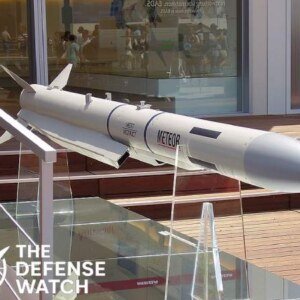Table of Contents
The European-built MBDA Meteor beyond-visual-range air-to-air missile (BVRAAM) has become a benchmark in long-range air-combat weaponry—not just in performance but in acquisition cost. Publicly available data place the unit cost around €2 million (approximately US$2.2 million) for 2019-era production. This figure highlights the premium nature of the weapon while also offering a useful comparator for air-arms budgeting and missile-procurement decisions.
Performance profile of the Meteor missile
Technical highlights
Developed by the multinational consortium led by MBDA Systems for six European partner nations (UK, Germany, Italy, France, Spain, Sweden), the Meteor is designed for air-superiority in highly contested environments.
Key publicly-stated characteristics:
- Weight: ~190 kg.
- Length: ~3.65–3.7 m.
- Diameter: ~178 mm (7 in).
- Propulsion: throttle-controlled ducted-rocket/ramjet motor enabling sustained thrust to target, enhancing the “no-escape” zone compared to conventional solid-rocket missiles.
- Range: Officially rated at “in excess of 200 km” in optimum conditions; no-escape zone often quoted at ~60 km+.
- Guidance: inertial mid-course update via two-way datalink, terminal active radar homing.
Operational context
The Meteor is already in service on platforms including the Saab JAS 39 Gripen, Dassault Rafale and the Eurofighter Typhoon, with planned integration on the F‑35 Lightning II (for partner nations) in the coming years.
Given its long-range, high-kinetic-energy flight phase and ability to operate in robust ECM environments, the missile is marketed as a “game-changer” in air-combat.
Meteor Missile Full detailed Specifications
- Guidance System: Active radar seeker with two-way datalink
- Maximum Speed: Over Mach 4
- Launch Compatibility: Eurofighter Typhoon, Rafale, Gripen
- Warhead Technology: Proximity-fused fragmentation warhead
-
Market data: cost per unit and procurement contracts
Known unit-cost figures
Several open-source references provide insight into the Meteor’s acquisition cost:
- Wikipedia lists the unit cost at €2,000,000 in 2019.
- A 2025 article pointed to a German procurement of ~€521 million for a batch of Meteor missiles, leading to an implied cost of approximately €1.93 million per missile (≈US$2.2 million) in that contract.
- A general commentary from 2023 estimated unit costs “around €2 million” for Meteor versus roughly US$2.5 million for the US AIM‑120 AMRAAM-C-8 variant.
Example contract: Germany
In November 2024 the German Bundestag approved the latest batch of Meteor missiles valued at around €521 million. While the exact number of missiles in the batch was not specified in every public summary, earlier pieces show an approximate cost per unit close to the €2 million mark. This suggests that large-volume procurement continues to stay in that ball-park.
Why cost matters
From an air-arm’s budgeting perspective, a missile costing ~€2 million sets a high bar. For example, equipping a squadron of fighters with Meteor missiles means significant procurement costs far beyond the cost of the aircraft alone in many cases. It also affects lifecycle costs (spares, training, maintenance) and export decisions: some nations may prefer lower-cost alternatives if long-range performance is less critical.
Analysis: Strategic implications of the cost benchmark
Value proposition vs. alternatives
The Meteor’s premium cost is justified to buyers based on its advanced propulsion (ramjet), extended endgame performance and wider no-escape zone. When compared to alternatives: one article argued that despite the higher technical performance, Meteor still came in cheaper than the newer AIM-120D3 variant (approx US$3.3 million per unit for Poland’s planned purchase).
Thus, the ~€2 million unit cost of Meteor becomes a benchmark for advanced BVRAAM pricing in Western-style air forces. Buyers assessing long-range air-to-air missile alternatives can gauge whether a given missile offers “Meteor-class” performance at comparable cost, or whether they are trading down in performance (and therefore cost).
Budget and export considerations
For emerging air-forces seeking to modernize fighter fleets, the cost of high-end missiles like Meteor may challenge procurement plans. As seen in India’s case, the local BVR missile (Astra Mk I) costs around US$1 million each—significantly cheaper—though with shorter range and somewhat different performance parameters.
In export markets, cost-competitiveness matters. A missile priced at ~€2 million may be acceptable for a nation acquiring high-end fighters and seeking maximum capability, but for less capable air-arms cost may push them toward cheaper systems with shorter reach. Additionally, lifecycle and integration costs must be factored in.
Industrial-policy dimension
From an industrial perspective, the Meteor programmed represents Europe’s push for sovereign missile-capability and independence from U.S. missile exports. The cost level also reflects joint development across multiple nations, which can affect unit-cost economies (scale, overheads). As cheaper U.S. or other non-European systems come online, the cost-performance balance could shift.
Summary
The MBDA Meteor missile stands out not only for its long range and advanced propulsion but also for the high acquisition cost—roughly €2 million (~US$2.2 million) per unit based on publicly reported contracts. This figure sets a benchmark for high-end BVR air-to-air missiles and serves as a reference point for air-forces planning procurements, budgeting for missile stocks, and assessing export options. While the cost is substantial, so too is the performance—including a large no-escape zone, advanced ramjet propulsion and high resistance to counter-measures.
The real value proposition will always depend on a nation’s threat environment, the type of aircraft they field, the number of missiles they’ll stock, and how they plan to integrate such weapons into their broader air-combat capability. Nonetheless, the cost detail provides an important reality check: state-of-the-art means premium pricing, and “Meteor-class” air-to-air capability is not inexpensive.
FAQs
What is the unit cost of the MBDA Meteor missile?Public sources indicate a unit cost around €2 million (approximately US$2.2 million) per missile in 2019/2024 contracts.
Why does the Meteor cost so much?The cost reflects its advanced features—ramjet propulsion, long-range no-escape envelope, active radar homing, two-way datalink, integration into high-end fighters, and European industrial development across multiple nations.
How does this cost compare with other missiles?For comparison, one article notes the U.S. AIM-120D3 missile unit cost for Poland is about US$3.3 million, making Meteor somewhat cheaper in that context.
Does the cost include aircraft integration and training?The published “unit cost” typically refers to the missile itself and likely excludes full integration, training, support infrastructure and lifetime maintenance; those additional costs can be substantial.
How many countries use the Meteor missile?The Meteor is in service with several European air forces and is selected for multiple fighter platforms.


